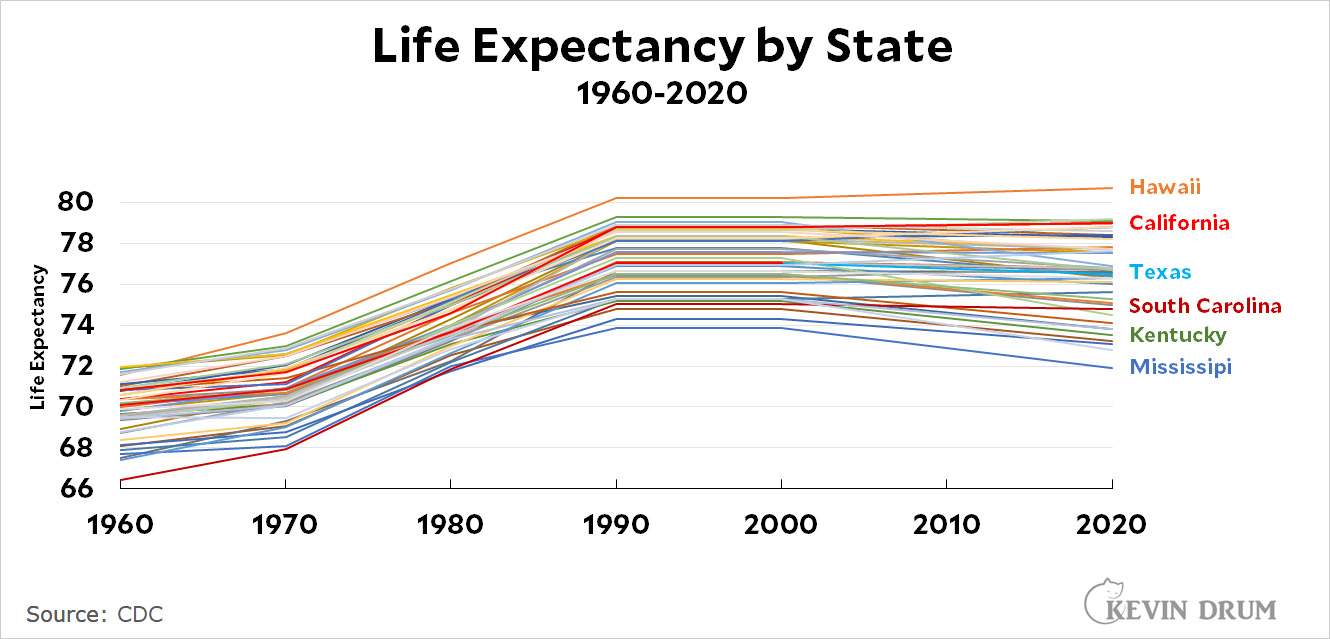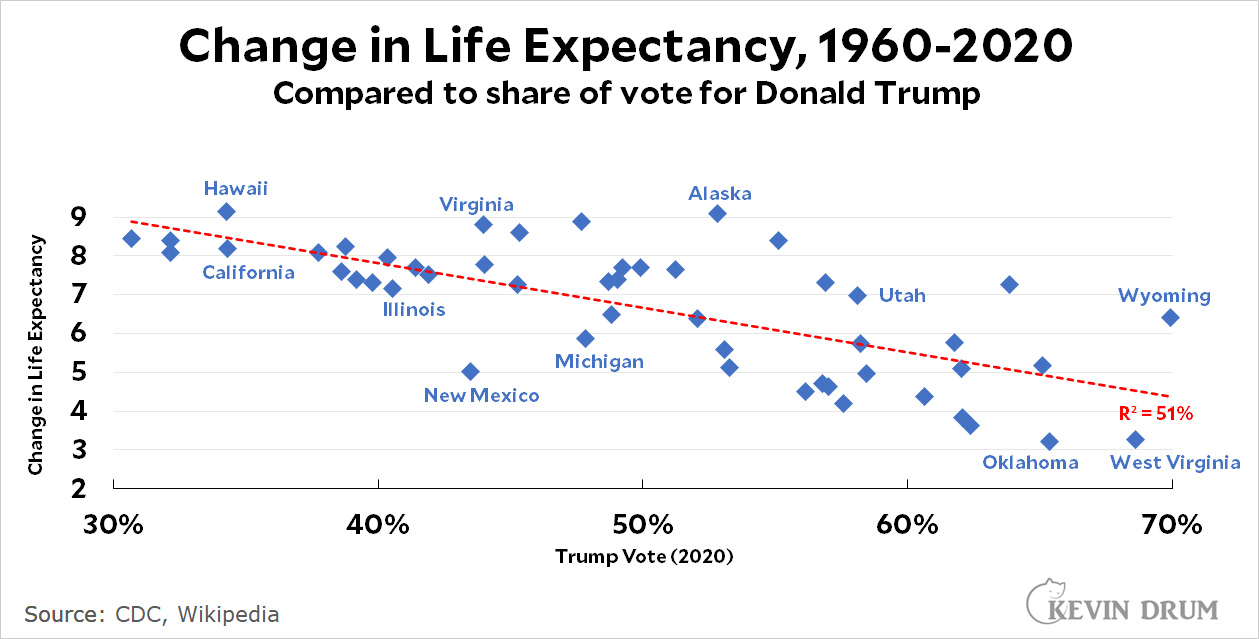Life expectancy has been in the news lately, so yesterday I was diddling around with the state-by-state data. Here it is:
 Generally, life expectancy increased through 1990, leveled out, and then began to drop in 2000. But the trend wasn't the same everywhere. Some states went up a little, while some dropped more than the others. Overall, the difference between the best and worst states increased by three years between 1960 and 2020. Even if you eliminate the top and bottom outliers the increase was still two years.
Generally, life expectancy increased through 1990, leveled out, and then began to drop in 2000. But the trend wasn't the same everywhere. Some states went up a little, while some dropped more than the others. Overall, the difference between the best and worst states increased by three years between 1960 and 2020. Even if you eliminate the top and bottom outliers the increase was still two years.
Here's what happened in the states with the worst trends in life expectancy:
 They voted for Donald Trump in 2020. And this correlation looks nearly as strong if I eliminate the eleven Southern states.
They voted for Donald Trump in 2020. And this correlation looks nearly as strong if I eliminate the eleven Southern states.
There are all sorts of confounders here, ranging from income to race to diet. So don't make too much of it. Nevertheless, it's yet another indication that the states in the worst condition are the ones that turn to people like Trump to rescue them.
UPDATE: More here from Jeremy Ney. It's from a couple of years ago but happened to pop up in my Twitter feed just as I published this post.

This consistency of poor decision making clearly requires a medical intervention.
That's right. It's not about the states in the worst shape turning to Trump for rescue. It's about the kind of states that support policies that lower life expectancy also support Trump. Trump is just another bad policy choice. These states are pro-death, and they have pro-death policies. (You'll probably find that they are anti-business as well which shows up in their weaker economies.)
Wow. I had no idea that life expectancy had declined for most states, and the country, since 2000…I thought it was just the past couple of Covid years. It would be more interesting to see the state details since 2000 (not 1960) when the decline really started. I imagine the D/R state differences would be even more pronounced.
Deaths of despair:
https://www.commonwealthfund.org/blog/2018/states-despair-closer-look-rising-state-death-rates-drugs-alcohol-and-suicide
Not a direct overlap--more in Appalachia and Mountain states--but ends in 2016.
Maybe graph against Medicaid as a resource?
77% of young Americans too fat, mentally ill, on drugs and more to join military, Pentagon study finds,
https://americanmilitarynews.com/2023/03/77-of-young-americans-too-fat-mentally-ill-on-drugs-and-more-to-join-military-pentagon-study-finds/
I do wonder how this fits with the geography of recruiting. " the top five states in 2016 were Hawaii, South Carolina, Georgia, Virginia and Florida" for military recruits as a percentage of 18-24 year olds in the state. "The five places with the smallest share of recruits were: Washington D.C., North Dakota, Massachusetts, Rhode Island and New York." That is to say, the unhealthiest states may be the source of more recruits. https://www.forbes.com/sites/chuckdevore/2020/02/19/states-that-defend-uswhere-do-our-military-volunteers-call-home/?sh=630a881534c9
The military is a path out of poverty that has always been attractive to people in areas with weak economies and little opportunity. It's especially attractive to anyone in an out-group or any ambition. It's no surprise that the unhealthiest states get more recruits. If you join the service, you get health care.
FWIW: Someone on twitter noted from the US map of coutnies that there was a belt of counties frunning along the coast and border from California to the tip of Texas with higher life expectancy. The comment was this reflected high Hispanic-population which is also correlated with long life.
Hispanic paradox,
https://www.health.harvard.edu/blog/life-expectancy-how-can-we-address-uneven-declines-2021042622466
The people in these states didn't turn to Trump (and people like him) to "rescue them." These people turned to Trump to "own the libs" by inflicting pain on them. They'd rather think their perceived enemies are being hurt than help themselves or their communities.
It's because these people think nothing is going to change their world or make their lives better, or worse, in any interesting or substantial way, but they can help to fuck with everyone else, so they're all in with that.
And they're kept in this state of juvenile feckless cynicism as an electoral strategy by the wealthy.
Seventy years ago these people would be taking Caribbean cruises to Tampico.
Does Political Ideology Play a Role in Destination Choice?
https://www.researchgate.net/publication/263325122_Does_Political_Ideology_Play_a_Role_in_Destination_Choice
The answer is yes. I would add that my impression is the perception of friendlier environments is playing at increasing role in where people take off to during the summer, --similar to assortitive mating where people of dissonant political ideologies are less and less likely to even know one another except by sheer chance, forming completely segregated communities and social groups.
"I voted for him, and he's the one who's doing this," she said of Mr. Trump. "I thought he was going to do good things. He's not hurting the people he needs to be hurting."
https://www.nytimes.com/2019/01/07/us/florida-government-shutdown-marianna.html
.... " it's yet another indication that the states in the worst condition are the ones that turn to people like Trump to rescue them."
Asked to explain his support for Trump a man in Waco said because Trump is the only candidate who would walk into a bar and throw all the bottles on the floor just to see where they land. To rescue them, perhaps, or at least to shake things up.
Actually, the image in https://americaninequality.substack.com/p/life-expectancy-and-inequality is plagiarized from a map of the Confederacy shortly after Bull Run.
How so? In 1865 N. Dakota, S. Dakota, and Montana weren't states yet.
I have heard that the rejection of Obamacare was a big factor in the mortality rates found in red states.
This trend is going to be stronger in a few years as COVID continues to wind through the country and rural medical practitioners pack it in. The growing disdain for all 'experts' who Faux news decides are today's enemy is pretty alarming.
Besides the antagonism of fact based medicine, you also have the potential criminalization of medical procedures related to pregnant women in most of those states. You have to be nuts to practice medicine in the deep red MAGA states.
The doctors can leave and then just ship them tons of horse dewormer and hydroxychloroquine. Good stuff to cure all ailments.
It might be interesting to create a graph that links each individual state to the country that most closely matches it in terms of life expectancy.
Here's four versions of that,
https://old.reddit.com/r/dataisbeautiful/comments/tylw0h/oc_us_states_matched_with_the_country_in_europe/
“Nearly as strong” I was curious about what an r-value such as in Kevin’s line implied. A bit of web searching later: https://www.dummies.com/article/academics-the-arts/math/statistics/how-to-interpret-a-correlation-coefficient-r-169792/
Speaking of r^2, does anybody else finde expressing it as a percentage a bit, um, nonstandard?
Canada's life expectancy is greater than 82,
https://vividmaps.com/us-life-expectancy-other-countries/
Living in a red state is a death sentence, and voting for conservatives is suicide.
2020 NVSR, figure 4 and table C are useful to measure COVID deaths, by state, which you can then apply against the 2020 vote margins.
Five lowest declines in life expectancy, primarily a feature of COVID:
Oregon, -0.8
Washington, -0.8
Maine, -0.5
New Hampshire, -0.4
Hawaii, -0.2
Hawaii had the highest conformity to mask-wearing (including outdoors) and social distancing.
For anyone wanting to review the life tables, from 1966 to 2020, you can find them here.
OT: SVB knew it was taking risks and deliberately altered its risk model to allow it to make those long-term bonds investments.
[sigh], just humming to myself. I still think there's a short somewheres though.